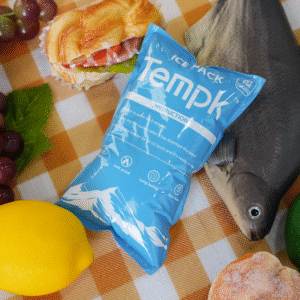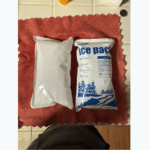Trockeneisbeutel für den Versand: So transportieren Sie temperaturempfindliche Güter sicher
Der Versand temperaturempfindlicher Waren erfordert eine zuverlässige Kühlmethode, um die Produktintegrität zu bewahren. Trockeneisbeutel sind seit langem die Lösung, um während des Transports gefrorene oder gekühlte Temperaturen aufrechtzuerhalten. Ob Versand von Lebensmitteln, Arzneimittel, oder andere verderbliche Waren, Trockeneis spielt eine entscheidende Rolle dabei, sicherzustellen, dass die Produkte die richtige Temperatur behalten. In diesem Leitfaden werden die Vorteile erläutert, Verwendung, und Sicherheitsaspekte beim Versand mit Trockeneis, zusammen mit Innovationen auf diesem Gebiet.
-
Warum sind Für den Versand notwendige Trockeneisbeutel verderbliche Güter?
-
Wie halten Trockeneisbeutel Waren auf der idealen Temperatur??
-
Welche Best Practices sollten Sie für einen sicheren und effektiven Trockeneisversand befolgen??
-
Welche Sicherheitsmaßnahmen sind bei der Verwendung von Trockeneis zu beachten??
Warum sind Trockeneisbeutel für den Versand notwendig??
Trockeneis ist unerlässlich, um verderbliche Waren auf der gewünschten Temperatur zu halten. Trockeneis ist festes Kohlendioxid (Co₂), das bei -78,5°C direkt vom Feststoff in den gasförmigen Zustand sublimiert (-109.3° F). Diese extrem niedrige Temperatur macht Trockeneis ideal für die Aufrechterhaltung des Gefrierzustands während des Versands, insbesondere für Produkte wie Impfstoffe, Meeresfrüchte, und biologische Proben.
Vorteile von Trockeneis für den Versand:
-
Temperaturregelung: Trockeneis hält die Gefrierbedingungen während des Transports aufrecht.
-
Kein Rest: Im Gegensatz zu normalem Eis, Trockeneis schmilzt nicht in Wasser, Dies verhindert Feuchtigkeitsschäden an den Produkten.
-
Lang anhaltende: Trockeneis dauert länger als traditionelles Eis, Dies macht es perfekt für längere Versanddauern.
| Merkmal | Beschreibung | Warum ist es wichtig |
|---|---|---|
| Temperaturbereich | -78.5°C | Hält Gegenstände gefroren oder gekühlt |
| Sublimationsrate | 5-10 Pfund pro Stück 24 Std. | Bestimmt die Menge an benötigtem Trockeneis |
| Versandvorschriften | Vorbehaltlich der DOT- und IATA-Regeln | Stellt die Einhaltung sicher, um Verzögerungen zu vermeiden |
Beispiel:
Ein Pharmaunternehmen berichtete, dass die Verwendung von Trockeneisbeuteln dazu beitrug, dass seine medizinischen Vorräte die erforderliche Temperatur länger aufrechterhielten 48 Std., Verderb durch 15%.
Wie funktionieren Trockeneisbeutel, um Waren auf der richtigen Temperatur zu halten??
Trockeneis funktioniert, indem es Wärme sublimiert und absorbiert. Durch diesen Kühleffekt bleiben temperaturempfindliche Gegenstände erhalten, wie Impfstoffe oder Tiefkühlkost, beim Versand auf die gewünschte Temperatur gebracht. Das Trockeneis sublimiert (verwandelt sich in Gas), Dadurch wird die Temperatur im Behälter kontinuierlich gesenkt, verhindert, dass sich die Ware erwärmt.
Schlüsselmerkmale von Trockeneisbeutel:
-
Sublimation: Trockeneis sublimiert stetig mit einer Geschwindigkeit von 5-10 Pfund alle 24 Std..
-
Kein Wasser: Als Trockeneis untermauert, Es verwandelt sich in Gas, Es bleibt kein Wasser zurück, das zu Undichtigkeiten oder Verderb führen kann.
-
Langzeitkühlung: Trockeneis kann für Abkühlung sorgen 24-72 Std., abhängig von Sendungsgröße und Isolierung.
Beispiel:
Für einen 24-Stunden-Transport von Fleisch oder Meeresfrüchten, Ein 10-Pfund-Trockeneisbeutel reicht normalerweise aus. Für längere Sendungen, Es werden mehrere Packungen oder größere Mengen benötigt.
Best Practices für die Verwendung von Trockeneis bei der Schifffahrt
Um eine optimale Leistung zu gewährleisten, Befolgen Sie diese Best Practices beim Versand mit Trockeneis:
-
Verwenden Sie isolierte Behälter: Kombinieren Sie Trockeneis mit einer hochwertigen Isolierung, um die Kühlwirkung zu verlängern. Isolierte Behälter tragen dazu bei, die Kühlkraft von Trockeneis zu erhalten.
-
Berechnen Sie den richtigen Betrag: Verwenden 5-10 Pfund Trockeneis pro 24-Stunden-Sendung für jeden 10-15 Pfund Produkt. Passen Sie es an die Versanddauer an.
-
Stellen Sie eine ordnungsgemäße Belüftung sicher: Trockeneis unterschwellt zu Kohlendioxidgas, Verwenden Sie daher immer gut belüftete Behälter, um einen Druckaufbau zu vermeiden.
| Empfohlene Aktion | Warum ist es wichtig |
|---|---|
| Verwenden Sie isolierte Behälter | Hält Produkte über längere Zeiträume auf der richtigen Temperatur |
| Berechnen Sie den richtigen Betrag | Verhindert übermäßigen oder unzureichenden Gebrauch von Trockeneis |
| Belüftung sicherstellen | Verhindert die Bildung gefährlicher CO₂-Gase |
Praktischer Tipp:
Für den Versand von Tiefkühlkost, Erwägen Sie die Verwendung von schaumisolierten Behältern, um die Haltbarkeit um bis zu zu verlängern 50% in Kombination mit Trockeneis.
Sicherheit bei der Handhabung und dem Versand von Trockeneis
Der Umgang mit Trockeneis erfordert sorgfältige Sicherheitsmaßnahmen. Die extrem niedrigen Temperaturen können zu schweren Erfrierungen führen, und die Sublimation von Kohlendioxidgas kann eine Erstickungsgefahr darstellen, wenn die Behälter nicht ordnungsgemäß belüftet sind.
Wichtige Sicherheitsrichtlinien:
-
Schutzausrüstung tragen: Tragen Sie beim Umgang mit Trockeneis stets Handschuhe und Schutzbrille, um Erfrierungen und Verletzungen vorzubeugen.
-
Richtige Kennzeichnung: Kennzeichnen Sie Sendungen, die Trockeneis enthalten, mit entsprechenden Gefahrenetiketten, um die Abfertiger zu benachrichtigen.
-
Belüftung sicherstellen: Behälter mit Trockeneis niemals verschließen. Lassen Sie das CO₂-Gas entweichen, um einen Bruch zu vermeiden.
| Sicherheitsmaßnahme | Empfohlene Aktion | Warum ist es wichtig |
|---|---|---|
| Schutzausrüstung tragen | Verwenden Sie Handschuhe und Schutzbrille | Verhindert Erfrierungen und Verletzungen |
| Beschriften Sie Behälter | Pakete deutlich mit „Trockeneis“ kennzeichnen | Macht Bediener auf potenzielle Risiken aufmerksam |
| Belüftung sicherstellen | Verwenden Sie die belüftete Verpackung | Verhindert die Bildung von CO₂-Gas |
Sicherheitsszenario:
Ein Lebensmittelhändler vermied Sicherheitsprobleme, indem er gut belüftete Versandbehälter verwendete und das Personal im richtigen Umgang mit Trockeneis schulte.
2025 Trends und Entwicklungen in der Trockeneisschifffahrt
Die Trockeneisschifffahrtsbranche entwickelt sich weiter. In 2025, Neue Innovationen verbessern die Temperaturkontrolle, Sicherheit, und Logistikeffizienz.
Wichtige Entwicklungen:
-
Intelligente Temperatursensoren: Diese Geräte informieren in Echtzeit über Temperaturänderungen während des Transports, Erhöhung der Sicherheit und Gewährleistung der Qualität temperaturempfindlicher Güter.
-
Blockchain für Rückverfolgbarkeit: Die Blockchain-Technologie wird in die Kühlkettenlogistik integriert, Bereitstellung einer transparenten Sendungsverfolgung und Gewährleistung der Temperaturintegrität.
-
Fortgeschrittene Isolationsmaterialien: Neue leichte und leistungsstarke Isoliermaterialien reduzieren den Trockeneisverbrauch und die Versandkosten.
Markteinsichten:
Mit der steigenden Nachfrage nach Tiefkühlkost und Arzneimitteln, Trockeneis spielt in der Kühlkettenlogistik eine immer wichtigere Rolle. Der weltweite Markt für Trockeneis wird voraussichtlich erheblich wachsen 2025, Trockeneis wird zur bevorzugten Lösung für den Transport verderblicher Güter.
FAQ
Q: Wie viel Trockeneis sollte ich beim Versand von Tiefkühlwaren verwenden??
Für jede 24-Stunden-Sendung, verwenden 5-10 Pfund Trockeneis pro 10-15 Pfund Produkt. Passen Sie den Betrag entsprechend der Versanddauer an.
Q: Ist Trockeneis versandsicher??
Ja, Trockeneis ist bei sachgemäßer Handhabung sicher für den Versand. Verwenden Sie immer gut belüftete Behälter und befolgen Sie die Sicherheitsrichtlinien.
Schlussfolgerung und Empfehlungen
Trockeneis ist ein unverzichtbares Hilfsmittel für den Versand verderblicher Waren. Durch die Berechnung der richtigen Menge Trockeneis, Gewährleistung einer ordnungsgemäßen Verpackung und Isolierung, und Einhaltung der Sicherheitsvorschriften, Sie können sicherstellen, dass Ihre Produkte die richtige Temperatur haben und in einwandfreiem Zustand ankommen.
Aktionsschritte:
-
Berechnen Sie die richtige Menge Trockeneis basierend auf der Sendungsgröße und -dauer.
-
Verwenden Sie isolierte Behälter und sorgen Sie für ausreichende Belüftung.
-
Befolgen Sie die Sicherheitsrichtlinien und bleiben Sie auf dem Laufenden 2025 Vorschriften.
Über Tempk
Tempk ist ein vertrauenswürdiger Marktführer in der Kühlkettenlogistik, ist auf die Bereitstellung hochwertiger Trockeneislösungen für die Schifffahrtsindustrie spezialisiert. Unsere umfassende Erfahrung stellt sicher, dass Ihre verderblichen Waren während des gesamten Transports die richtige Temperatur haben, Gewährleistung sicherer und zuverlässiger Lieferungen.
Aufruf zum Handeln:
Kontaktieren Sie Tempk noch heute, um weitere Informationen darüber zu erhalten, wie unsere Trockeneislösungen Ihren Versandprozess optimieren können.
























